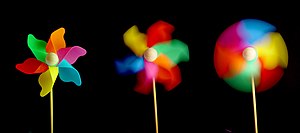 Image via Wikipedia
Image via WikipediaAlmost a year past, and I ask myself, where am I now in my
photography journey?
I've read a ton of books. After finishing about 5, I find that most of the books are discussing simply the same idea 99%. The 1% difference is the individuality of the
authors - and this is but the cream of the written word. And for most authors, they are sharing their skills and experience in the hope that you can also become like one of them. Of course I mean to say that you become like one of them in their level of photography. For some other authors, they just go through the yaadah-yaadah part of their
photographs, their techniques, etc., etc., but none of their skills that can be acquired by the reader - in time. And photography being such an individualistic art, or should I say, a very subjective display of talent, I would tend to question those who would not want to share their talent to others - for they can never be copied or replaced - they are their own photographer, and you are your own. for even though the techniques are the same, it is your individuality and uniqueness that shows in your photographs. That is all the essence then, and is now, and will be.
I've not been into a park or mountain or cliff, or any grand photograph site for that matter. However, I have not limited my photography to the use of my DSLR. I also use my cell phone whenever opportunity is presented. Like the recent haze here in
Singapore, where the sun was in orange. What can I say, as advocated by more than 1 author, a photographer has to come out of being a simple phot-taker, snapping the ordinary, photographing the obvious. To set your own mark, you would have to have an eye on the extra-ordinary, or the un-obvious, or the unfamiliar view. And this is done whether or not you are caryying your camera with you.
Keeping my photos, though they are nice or not. One book suggests immeidately deleting your bad photos. The reason presented is to be able to save some space in your
SD card or harddisk. Secondly is to not "confuse" your good photos with the bad photos. Thirdly is that when you "showcase" your photos, the list is already edited and the bad ones removed. For some time I followed this advise. Then I thought to myself, why should I? You see, I am one who would like to 'keep' my 'unfortunate' snaps - of course, as a leaning tool. Seeing the shoots that didn't make the mark helps me to focus on my
learning - not repeating the same mistake the next time I push the button. Of course, this doesn't happen overnight, but what better way for you to find out how far you've been progressing if you don't have a 'show of it'?
I have subscribed to a digest or a forum. Basically, I signed up to Digital Photography School by
Darren Rowse, and I like being in the list. Quite a lot to be learned from fellow photographers, to mention the least. there there are tips and tricks from experienced, or should I say, professional, photographers? Get in the list yourself.
Another group that I signed up to is
Digital SLR Guide Newsletter by Chris Roberts. It isn't quite verbose compared to Digital Photography School, but there's a grain of wisdom that can be gleaned from it just the same.
And finally, whatever level of photography you are in, there is always the chance to be yourself in your photographs - something that shouldn't be daunted by the other photographs that you see. keep on snapping and learning, and learning and snapping. Your time will come. And your photos will be on the great wall for others to admire.
Now isn't that something to make you keep on with your photography journey?
 While in the rented flat, I've been able to use only my Samsung Omnia II phone to take pictures of the views presented to me now and then. And so, while not quite dramatic, the essence is still there. I have a picture of the sunrise, and a picture of the sunset. Some that I've taken are blur, but I managed to get quite clear takes.
While in the rented flat, I've been able to use only my Samsung Omnia II phone to take pictures of the views presented to me now and then. And so, while not quite dramatic, the essence is still there. I have a picture of the sunrise, and a picture of the sunset. Some that I've taken are blur, but I managed to get quite clear takes.




![SNC00187[1] SNC00187[1]](http://lh6.ggpht.com/_JPNLPPFDxSA/TLJhlQnGv1I/AAAAAAAAHQ4/aWl8wSp7rFQ/SNC00187%5B1%5D_thumb%5B1%5D.jpg?imgmax=800)





![Reblog this post [with Zemanta]](http://img.zemanta.com/reblog_e.png?x-id=f3779b0c-460d-4178-ac14-f884566d490c)





![Reblog this post [with Zemanta]](http://img.zemanta.com/reblog_e.png?x-id=eda09c26-474d-4192-aabb-4c678cc616a6)



![Reblog this post [with Zemanta]](http://img.zemanta.com/reblog_e.png?x-id=264f2158-7b5f-42d0-b719-6c07dd521f32)




![On Assignment: Video Guide to Basic 35mm Photography [VHS]](http://ws.amazon.com/widgets/q?MarketPlace=US&ServiceVersion=20070822&ID=AsinImage&WS=1&Format=_SL160_&ASIN=6301062868&tag=healatho-20)

![Reblog this post [with Zemanta]](http://img.zemanta.com/reblog_e.png?x-id=6d31ba5e-de89-4eeb-b932-e4a6155c2fac)

![Reblog this post [with Zemanta]](http://img.zemanta.com/reblog_e.png?x-id=80b06f2c-5cdc-458b-b139-858720771ea9)